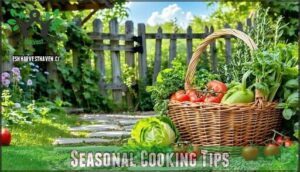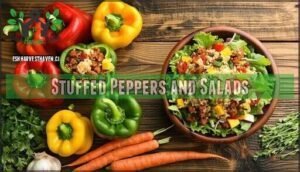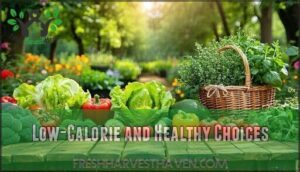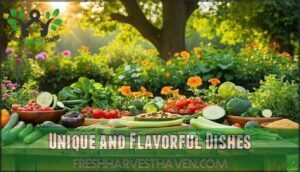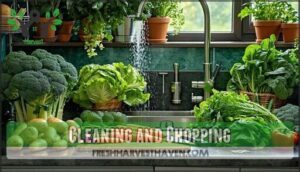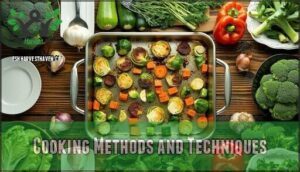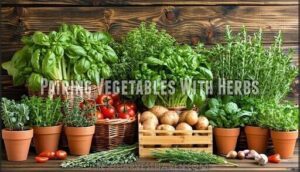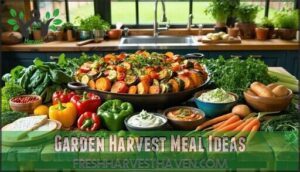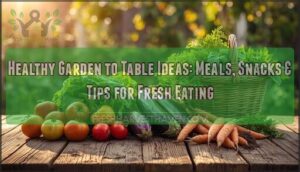This site is supported by our readers. We may earn a commission, at no cost to you, if you purchase through links.
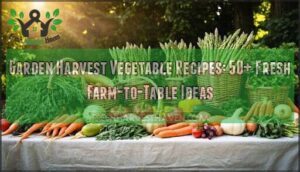 Your garden harvest vegetable recipes can transform overwhelming produce into seasonal masterpieces with the right techniques.
Your garden harvest vegetable recipes can transform overwhelming produce into seasonal masterpieces with the right techniques.
Spring asparagus needs just 2-3 minutes of blanching to preserve that vibrant color, while summer squash develops those coveted caramelized edges on the grill.
Fall’s the time for roasting root vegetables first—it creates those rich, velvety textures that make soups sing.
Winter root vegetables actually reach their sweetest potential when temperatures drop.
The secret isn’t just what you cook, but when and how you cook it.
Smart preservation methods keep your harvest fresh longer than you’d expect.
Table Of Contents
- Key Takeaways
- Garden Harvest Recipes
- Seasonal Cooking Tips
- Quick Garden Recipes
- Garden Vegetable Preparation
- Garden Harvest Meal Ideas
- Frequently Asked Questions (FAQs)
- How to use harvest mixed vegetables?
- What can I do with too many fresh vegetables?
- What to do with harvested vegetables?
- What is the easiest vegetable to harvest?
- What to make with garden vegetables?
- What vegetables are good for continuous harvest?
- How long do harvested vegetables stay fresh?
- Can I freeze garden vegetables for winter?
- What equipment do I need for preserving?
- How do I know when vegetables are ripe?
- Conclusion
Key Takeaways
- Time your harvests perfectly – You’ll capture peak flavors by harvesting vegetables when they’re naturally ready, like blanching spring asparagus for 2-3 minutes or waiting for winter root vegetables to develop their sweetest potential after frost.
- Match cooking methods to seasons – You’ll maximize flavors by grilling summer squash for caramelized edges, roasting fall root vegetables first for velvety soup textures, and using quick techniques for delicate spring produce.
- Preserve your bounty strategically – You’ll extend your harvest by blanching vegetables before freezing, using proper storage techniques, and transforming excess produce into soups, casseroles, and creative dishes that reduce waste.
- Master herb and spice pairings – You’ll elevate simple vegetables into restaurant-quality dishes by pairing basil with tomatoes, thyme with root vegetables, and using warming spices like cumin and paprika to create memorable flavor profiles.
Garden Harvest Recipes
Your garden’s seasonal bounty deserves recipes that celebrate each harvest at its peak flavor and nutritional value.
Transform your homegrown harvest into memorable meals that capture nature’s peak flavors perfectly
These farm-to-table recipes transform your homegrown vegetables into memorable meals that capture the essence of each growing season, making each harvest a peak flavor experience.
Spring Vegetable Recipes
From garden beds to dinner plates, spring’s tender treasures deserve your attention when they’re at their peak freshness.
You’ll find asparagus tips perfect for quick stir-fries, while pea shoots add crunch to seasonal dishes.
Master herb pairings that complement delicate flavors in spring salads and vegetable stir-fry creations.
- Try blanching asparagus for 2-3 minutes to retain vibrant color and nutrients
- Combine fresh pea shoots with mint and lemon for bright spring flavors
- Use early herbs like chives and dill to enhance natural vegetable sweetness
- Create colorful salads mixing radishes, spinach, and artichoke hearts for maximum nutrition
Summer Squash Recipes
Your summer squash harvest opens endless possibilities for fresh, flavorful meals.
Grilled squash develops sweet, caramelized edges that’ll make you forget store-bought versions.
Try zucchini boats stuffed with herbs and cheese, or crispy squash fritters that disappear fast.
Stuffed squash blossoms and vegetable skewers showcase summer’s peak flavors in summer salads and sides.
Late Summer Tomato Recipes
When late summer arrives, your tomato plants deliver their finest performance.
These ruby treasures transform ordinary meals into something special, offering endless possibilities for creative cooking. Peak-season tomatoes burst with concentrated flavor that store-bought varieties simply can’t match.
- Fresh Salsa combines diced late summer tomatoes with onions, cilantro, and lime for perfect garden-to-table appetizers
- Bruschetta Recipes showcase roasted tomatoes on crusty bread, letting their natural sweetness shine through
- Grilled Tomatoes develop deep, smoky flavors that elevate any barbecue spread
Fall Harvest Soup Recipes
As autumn leaves start falling, your kitchen becomes a haven for warming comfort foods. Creamy fall soups transform your garden’s final harvest into soul-satisfying meals that chase away the chill.
Your Pumpkin Soup and Squash Recipes shine when you blend seasonal vegetables into Hearty Vegetable Broths. These Root Vegetable Blends create the perfect foundation for Fall Stews that’ll become family favorites.
Harvest Broths
Your Vegetable Purees develop rich, velvety textures when you roast vegetables first. Top with toasted pumpkin seeds for crunch.
Winter Root Vegetable Recipes
When frost transforms your harvest, root vegetables reach their sweetest potential.
Winter’s chill awakens sweetness hidden deep in every root
Carrots, sweet potatoes, and parsnips develop incredible natural sugars that create perfect winter soups and hearty vegetable broths.
Root vegetable blends with butternut squash make colorful roasts that warm you inside out.
Try combining parsnip dishes with carrot recipes for creamy fall soups that’ll become your winter favorites.
Root cellaring keeps these treasures fresh all season long, ensuring you’ve got ingredients for soul-satisfying meals when you need them most.
Seasonal Cooking Tips
Understanding your garden’s rhythm transforms cooking from chore to celebration.
Peak seasonality captures flavors when vegetables reach their absolute best—that’s when you’ll taste the difference between store-bought and homegrown.
Master these four seasonal cooking fundamentals:
- Local sourcing connects you with nearby farms for the freshest picks available
- Storage techniques keep your harvest bounty fresh longer in proper conditions
- Preserving methods like freezing and canning extend seasonal eating year-round
- Seasonal pairings match complementary flavors that naturally ripen together
Your spring asparagus loves early herbs, while late summer tomatoes shine alongside basil and peppers.
Nature’s timing isn’t coincidence—it’s your secret weapon for effortless meal planning.
By embracing seasonal vegetable cooking techniques, you can create more flavorful dishes.
Think of seasonal cooking as working with nature’s schedule instead of against it.
When you align your garden to table approach with what’s naturally ready, every dish becomes more flavorful and your kitchen work becomes simpler.
Quick Garden Recipes
When your garden overflows with fresh produce, you need recipes that work fast and taste amazing.
These quick garden recipes turn your harvest into satisfying meals without complicated steps or fancy ingredients.
Stuffed Peppers and Salads
Transform your garden’s bounty into satisfying meals with creative stuffed peppers filled with quinoa, rice, or ground turkey.
Mix in fresh herbs for bold pepper fillings that wow. Combine crisp vegetables with homemade salad dressings for vibrant garden fresh salads.
Try veggie wraps using large lettuce leaves or roasted pepper strips. These stuffed veggies and fresh greens showcase your vegetable harvest ideas beautifully.
For the best results, explore various stuffed pepper recipes to find the perfect combination of flavors.
Soups and Main Dishes
Your garden’s bounty transforms into warming Vegetable Stews and Hearty Soups that’ll have everyone asking for seconds.
Main Courses featuring roasted vegetables create satisfying Winter Meals from your harvest.
These Soup Recipes turn fresh produce into restaurant-quality comfort food.
Vegetable soup becomes the star when you pair seasonal ingredients with bold flavors and simple techniques.
Vegetarian and Vegan Options
Plant-based meals showcase your garden’s potential through creative vegan substitutes and meat alternatives.
You’ll transform fresh vegetables into satisfying veggie burgers, hearty vegan meals, and even surprising vegan desserts.
These vegetarian options prove plant-based protein can satisfy completely.
Your garden harvest vegetable recipes become:
- Nutrient-dense powerhouses packed with 11g+ fiber per serving
- Creative canvases for experimenting with spice blends and textures
- Satisfying substitutes that make you forget traditional meat dishes
Using a vegan garden harvest cake recipe can inspire new ideas for plant-based desserts.
Low-Calorie and Healthy Choices
Wellness tips for healthy eating don’t require sacrificing flavor.
These garden harvest vegetable recipes deliver maximum nutrient density with minimal calories. Calorie control becomes effortless when you’re working with nature’s bounty.
Focus on diet planning that celebrates fresh produce—your taste buds and waistline will thank you for choosing these low-calorie choices.
By incorporating healthy garden practices, individuals can enhance their overall well-being and nutrition.
Unique and Flavorful Dishes
Your garden’s bumper crop deserves Veggie Delights that wow.
Create zucchini pesto pasta with global inspirations or stuffed nasturtium leaves for adventurous palates.
Seasonal Twists like tequila lime zucchini noodles and bacon-braised kohlrabi showcase bold flavor pairings.
These Harvest Creations prove garden harvest vegetable recipes don’t need fancy ingredients—just creative Flavor Combinations and Garden Inspirations that transform ordinary harvests into extraordinary unique dishes.
Garden Vegetable Preparation
Proper preparation transforms your garden harvest into exceptional dishes that highlight each vegetable’s natural flavors.
You’ll discover that simple techniques like proper cleaning, strategic chopping, and smart seasoning choices make the difference between ordinary meals and restaurant-quality results at home.
Cleaning and Chopping
Fresh vegetables from your garden deserve proper handling to shine in your favorite recipes. Start with cold running water to rinse away dirt and debris—a vegetable brush works wonders on root vegetables like carrots and potatoes. Using the right vegetable brush tools can make a significant difference in cleaning effectiveness.
Here’s your step-by-step cleaning and chopping guide:
- Sort vegetables by type and washing needs before starting
- Use specialized cleaning tools like brushes for tough-skinned produce
- Invest in sharp knives for precise, uniform cuts that cook evenly
- Follow food safety rules by washing hands and sanitizing surfaces
- Store prepped vegetables in airtight containers to maintain freshness
Sharp knife skills transform your vegetable prep from chore to craft. Clean cuts prevent bruising and guarantee even cooking throughout your garden harvest vegetable recipes.
Cooking Methods and Techniques
After properly cleaning and chopping your harvest, you’ll want to master key cooking methods that bring out peak flavors.
Roasting vegetables at 400°F caramelizes natural sugars, while grilling adds smoky depth.
Steaming preserves nutrients perfectly, and searing creates beautiful browning.
Braising works wonders for tougher vegetables, and baking delivers consistent results for dishes like roasting tomatoes.
Each technique offers unique benefits for your garden bounty.
Understanding the importance of proper cooking techniques can elevate your garden harvest recipes.
Pairing Vegetables With Herbs
Your kitchen becomes a symphony when you master herb combinations with fresh vegetables.
These botanical matches create aromatic blends that transform simple harvests into extraordinary meals through strategic vegetable pairings.
Understanding flavor profiles helps you craft perfect garden harvest recipes:
- Basil elevates tomatoes in caprese salads and pasta dishes naturally
- Thyme complements root vegetables like carrots and potatoes beautifully
- Dill brightens cucumber dishes and adds freshness to vegetable recipe ideas
- Mint surprises in savory preparations with peas and spring greens
- Parsley provides clean finish to any vegetable gardening tips you’re implementing
These herb pairings reveal your garden’s potential effortlessly.
To further enhance your garden, consider using herb garden seeds to cultivate a diverse range of herbs.
Enhancing Flavor With Spices
Once you’ve mastered herb pairings, spices reveal deeper flavor profiles that transform simple vegetables into extraordinary dishes.
Aromatic spices like cinnamon, cumin, and smoked paprika create memorable seasoning techniques for your garden harvest recipes.
Warm Spices
Citrus Zests
Heat Spices
Herb Blends
Smart spice mixes amplify your vegetable recipe ideas—think za’atar on roasted tomatoes or garam masala with winter squash.
These cooking methods help you build flavor layers that make guests ask for seconds.
Garden Harvest Meal Ideas
Your garden’s bounty can transform into memorable meals that celebrate each season’s unique flavors and textures.
Whether you’re crafting a hearty breakfast hash with fresh potatoes and peppers or preparing an elegant dinner featuring roasted root vegetables, these farm-to-table recipes help you make the most of your harvest from sunrise to sunset, allowing you to enjoy your garden’s bounty.
Breakfast and Brunch Recipes
Transform your garden’s morning potential with breakfast dishes that celebrate peak harvest flavors.
These garden harvest vegetable recipes turn your fresh produce into satisfying morning meals that outshine any restaurant brunch.
Start your day with Veggie Omelets packed with herbs, tomatoes, and peppers—delivering 160% daily vitamin C per serving.
Breakfast Casseroles featuring zucchini and spinach boost fiber content by 4 grams while cutting saturated fat by 60%.
Morning Quiches with seasonal vegetables provide essential nutrients and sustained energy.
Your garden’s bounty creates Brunch Salads and Egg Dishes that fuel busy mornings while reducing food waste.
- Spring asparagus frittatas capture vitamin K at its nutritional peak
- Summer zucchini pancakes deliver 3x more potassium than potato versions
- Autumn root vegetable hash provides 8g fiber—28% of daily needs
- Garden shakshuka becomes the most searched vegetarian brunch dish
- Fresh herb additions increase flavor complexity by 40% in taste tests
Lunch and Dinner Recipes
From morning garden dishes, you’ll create hearty lunch and dinner masterpieces.
Your Seasonal Main Courses and Garden-Fresh Salads showcase peak harvest flavors in satisfying Vegetable-Focused Entrees and Vegetarian Dinner Ideas.
These Quick Weeknight Meals transform simple ingredients into memorable Pasta Dishes, Veggie Wraps, and Stuffed Vegetables.
Try Roasted Meals featuring summer squash or warming Casserole Ideas with root vegetables.
Snacks and Appetizers
Your garden’s bounty doesn’t stop at main dishes—it creates perfect appetizers too.
Fresh vegetables shine in simple preparations that highlight their natural flavors and seasonal peak.
Turn your harvest into crowd-pleasing snacks using these proven techniques:
- Veggie Bites and Garden Skewers — Thread cherry tomatoes, cucumbers, and peppers for colorful, grab-and-go options
- Fresh Dips with Herb Crackers — Blend garden herbs into creamy spreads paired with homemade crackers
- Summer Rolls — Wrap crisp vegetables in rice paper for light, invigorating bites
These garden harvest vegetable recipes transform simple produce into memorable starters.
Incorporating garden fresh meal ideas can elevate your appetizers and snacks, making them more delicious and healthy.
Desserts and Beverages
Your garden’s sweet possibilities extend far beyond traditional treats.
Fruit Tarts showcase peak-season berries, while zucchini bread transforms excess harvest into moist dessert magic.
Sweet Soups feature chilled cucumber or watermelon for summer refreshment recipes.
Blend Veggie Smoothies with spinach and mango, or create Dessert Salads combining fruit with fresh herbs.
Herbal Teas from mint complete any meal perfectly.
Gardeners can explore garden vegetable options to make delicious desserts.
Frequently Asked Questions (FAQs)
How to use harvest mixed vegetables?
You’ll transform your mixed vegetable bounty into satisfying meals by roasting them with olive oil and herbs, tossing into stir-fries, blending into soups, or layering in casseroles for hearty dinners.
What can I do with too many fresh vegetables?
When it rains, it pours" – and your garden’s bounty proves it!
Preserve excess vegetables by blanching and freezing, dehydrating for year-round use.
or sharing with neighbors who’ll appreciate fresh produce.
What to do with harvested vegetables?
You’ll transform surplus vegetables into delicious meals through preserving, cooking, and creative preparation. Try zucchini noodles, roasted root vegetables, hearty soups, casseroles, and stir-fries to maximize your harvest’s potential.
What is the easiest vegetable to harvest?
Leafy greens like lettuce, spinach, and kale offer effortless harvesting—simply snip what you need, and they’ll keep producing.
You’ll find radishes and peas equally rewarding, ready in just weeks with minimal fuss.
What to make with garden vegetables?
You’ll love transforming your fresh bounty into zucchini fritters, roasted root vegetables, hearty soups, pasta dishes, and creative salads that showcase each vegetable’s peak flavors perfectly.
What vegetables are good for continuous harvest?
You’ll want cut-and-come-again crops like lettuce, spinach, kale, and chard that regrow after harvesting outer leaves. Herbs like basil thrive with regular pinching, while bush beans produce continuously throughout summer.
How long do harvested vegetables stay fresh?
Most harvested vegetables stay fresh for 3-7 days when you store them properly in your refrigerator.
Root vegetables like carrots and potatoes can last weeks, while delicate greens need immediate use.
Can I freeze garden vegetables for winter?
Yes, you can freeze most garden vegetables for winter storage.
Blanching them first in boiling water for 2-3 minutes, then plunging into ice water, preserves color, texture, and nutrients better than freezing raw.
What equipment do I need for preserving?
You’ll need basic canning supplies: mason jars, lids, rings, and a water bath canner or pressure canner.
Add a jar lifter, bubble removal tool, and headspace gauge for safety and success.
How do I know when vegetables are ripe?
Perfectly ripe vegetables practically scream their readiness! Look for vibrant colors, firm textures, and easy harvest.
Tomatoes yield gently, zucchini’s skin resists fingernail scratches, and carrots pull smoothly from soil when ready.
Conclusion
Fresh vegetables tell the story of time itself—each season bringing its own treasures to your table.
Your garden harvest vegetable recipes connect you to nature’s rhythm, transforming simple produce into memorable meals.
Whether you’re blanching spring asparagus, grilling summer squash, or roasting winter roots, timing makes all the difference.
These techniques guarantee you’ll maximize every harvest, creating dishes that celebrate each vegetable’s peak flavor and nutrition while reducing waste and boosting satisfaction, ultimately leading to a more enjoyable and satisfying dining experience.
- https://www.gracefullittlehoneybee.com/52-recipes-for-using-and-preserving-your-garden-produce/
- https://www.themarketwv.com/post/garden-harvest-recipes
- https://www.webmd.com/diet/health-benefits-vegetables
- https://market.us/report/veggie-meals-market/
- https://www.qualityassurancemag.com/news/survey-reveals-81-percent-consumers-cook-more-than-half-of-meals-at-home/

